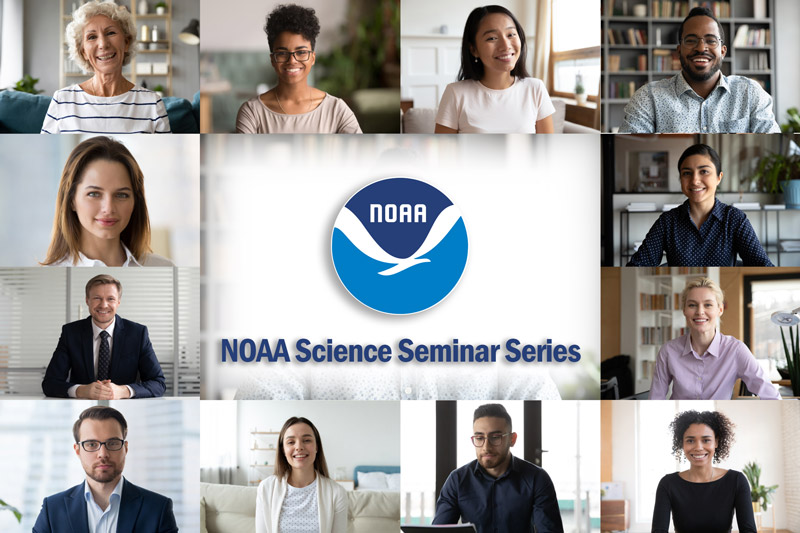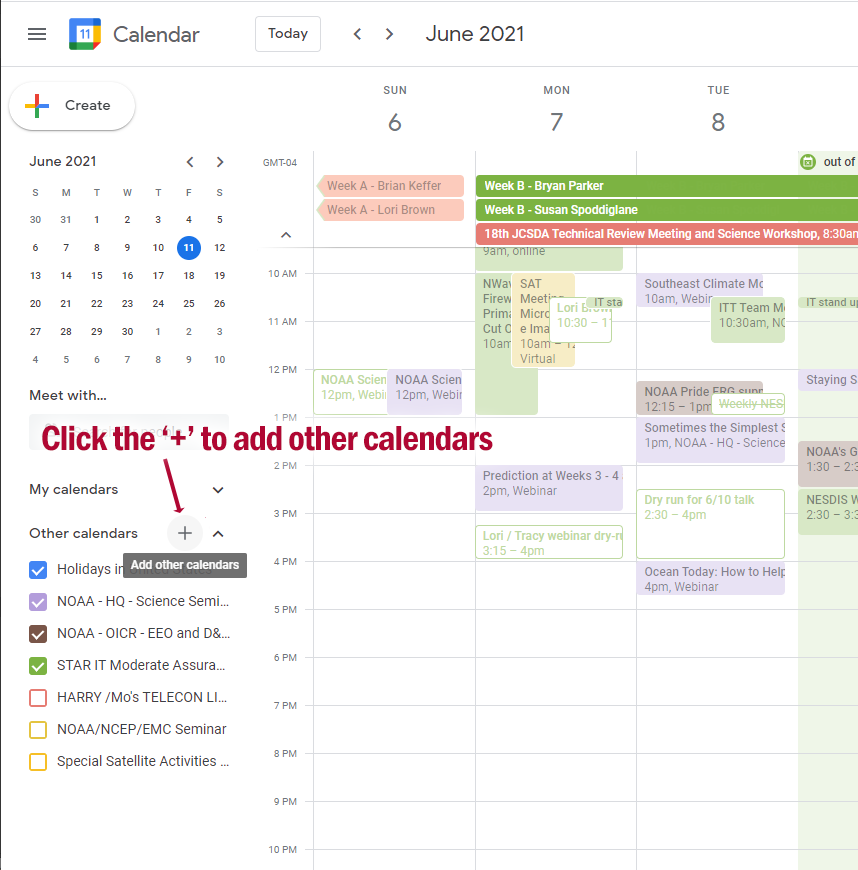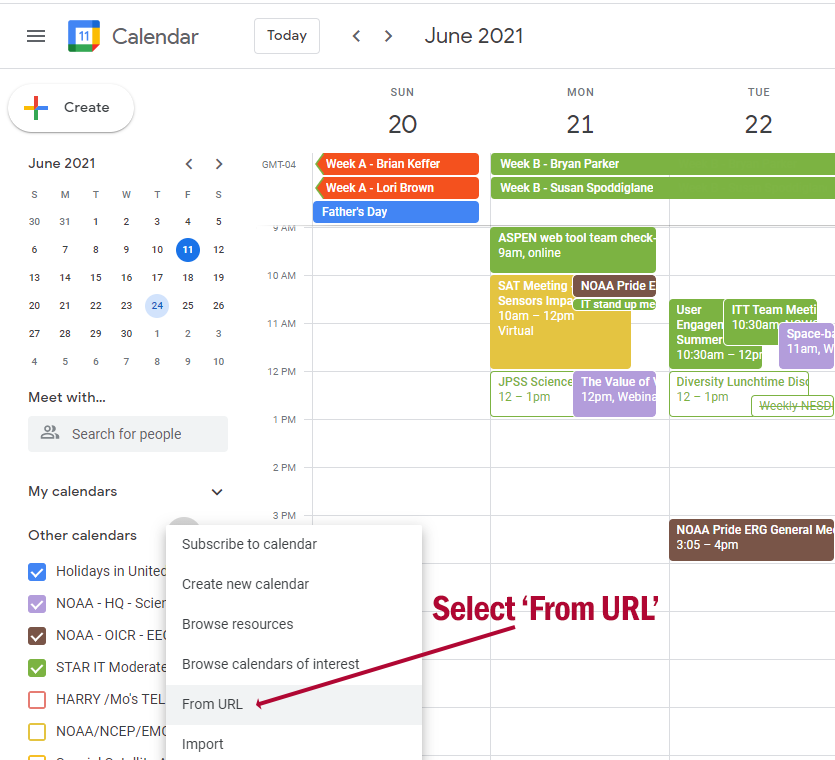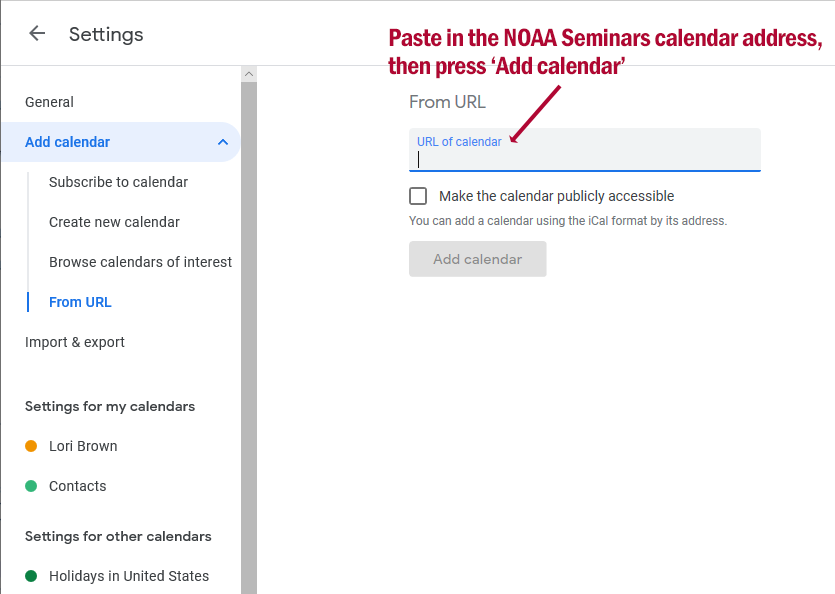NOAA Science Seminar Series

The NOAA Science
Seminar Series began in 2004 and is a voluntary effort by
over 70 NOAA seminar coordinators to integrate and distribute a list of
NOAA-hosted, publicly accessible science seminars. In 2020
we shared listings for over 500 seminars!
- NOAA Science Seminars Contributors
- For general questions about the NOAA Science Seminar Series, the calendar,
and weekly e-mail, contact Lori Brown.
- For questions specific to a particular seminar,
email the contact listed in the seminar description.
Add the NOAA Science Seminar Series to your Google Calendar
If you would like to add the NOAA Science Seminar Series to your
own Google calendar view:

Add the seminar calendar, screen 1
(click to enlarge)
- Open your Google Calendar:
https://calendar.google.com/
- On the lower left hand side, look for 'Other calendars'
- Click the plus sign + to
'Add other calendars'

Add the seminar calendar, screen 2
(click to enlarge)

Add the seminar calendar, screen 3
(click to enlarge)
- Click the blue button that says 'Add Calendar'
- Close the 'Settings' panel for your calendar
- You should now see the NOAA - HQ - Seminar Series
events on your own calendar view.
Listings in Google Calendar Format
Google
calendar of seminar listings
How to Contribute
- All NOAA Program Offices are welcome to share their hosted science-related
seminars as part of the NOAA Science Seminar Series effort.
- To become a seminar calendar contributor, e-mail Lori Brown.
Once you are approved as a contributor to the calendar, you are able to add
& update seminars on the calendar. We use the data from this Google calendar to populate the
listings for both e-mails and the seminars page.
- We ask seminar contributors to follow our formatting and content guidelines,
which helps us keep the seminar listings consistent across all our contributors.
- Seminar submission guidelines
- Privacy Statement / Disclaimer, (DOCX, 17 KB)
- NOAA Science Seminars Contributors
- For additional information please contact
Lori.Brown@noaa.gov.
All seminar are listed in Eastern Time
Expand All Seminar Details
17 December 2025
| Title: |
Identifying the bacteria responsible for sea star wasting disease in the sunflower sea star (Pycnopodia helianthoides) |
| Presenter(s): |
Melanie Prentice, Research Scientist, Hakai Institute |
| Date & Time: |
17 December 2025
2:00 pm - 3:00 pm ET |
| Location: |
online |
| Description: |
NOAA Science Seminar SeriesTitle: Identifying the bacteria responsible for sea star wasting disease in the sunflower sea star (Pycnopodia helianthoides) NOAA Library Seminar Presenter(s): Melanie Prentice, Research Scientist, Hakai Institute Sponsor(s): NOAA 'Omics and NOAA Library Seminar Contact(s): Nicole Miller ( nicole.miller@noaa.gov) and library.seminars@noaa.govRemote Access: https://vimeo.com/event/5534109Abstract: Beginning in 2013, a prolific epidemic of sea star wasting disease (SSWD) swept the Pacific Coast of North America. Today, outbreaks of SSWD in this region continue. Across the two dozen asteroid species suspected to be afflicted by SSWD, the sunflower sea star has experienced the greatest losses, >90% of the global population of P. helianthoides has been lost in the last decade.The rapid disappearance of P. helianthoides further contributed to a trophic cascade involving unchecked population growth of their sea urchin prey which then overgrazed kelp forests. Key to the recovery of P. helianthoides and the kelp forest ecosystems, is the identification of the causative agent for SSWD. In this talk we present data leveraged from controlled challenge experiments and natural field outbreaks of SSWD in P. helianthoides to identify Vibrio pectenicida strain FHCF-3 as a causative agent of this disease. Keywords: Sea star wasting disease, sunflower sea star, pathogen identification Accessibility: Captions are available during the live presentation and once uploaded to the NOAA Central Library YouTube Channel automatic captions are added. Sign language interpreting services and closed captioning are available, but need to be requested at least 5 days before the event. Recordings: Recordings will be shared 24 hours after the event on the NOAA Library YouTube channel. Subscribe to the NOAA Science Seminar Series weekly e-mail: Send an e-mail to OneNOAAscienceseminars-request@list.woc.noaa.gov with the word 'subscribe' in the subject or body. Visit the NOAA Science Seminar Series website for more information. We welcome your suggestions and ideas! |
| Add seminar: |
Add
to Google calendar |
18 December 2025
| Title: |
From Data Deficient to Big Data in Shark Conservation |
| Presenter(s): |
Francesco Ferretti, Virginia Tech, Assistant Professor of Fish and Wildlife Conservation |
| Date & Time: |
18 December 2025
11:00 am - 12:00 pm ET |
| Location: |
TBD |
| Description: |
NOAA Science Seminar Series
Title: From Data Deficient to Big Data in Shark Conservation
NOAA Library Seminars
Presenter(s): Francesco Ferretti, Virginia Tech, Assistant Professor of Fish and Wildlife Conservation
Sponsor(s): NOAA Education and NOAA Library
Seminar Contact(s): library.seminars@noaa.gov
Remote Access: https://vimeo.com/event/5495366
Accessibility: Captions are available during the live presentation and once uploaded to the NOAA Library YouTube Channel automatic captions are added. Sign language interpreting services and closed captioning are available, but need to be requested at least 5 days before the event.
Abstract: Citizen science and digital technologies offer cost-effective ways to address critical knowledge gaps for endangered, data-poor species like sharks, many of which are declining due to overfishing. To meet this need, we developed sharkPulse, a platform that automates the ingestion of online shark images to build the largest database of shark occurrence records to date. This approach provides a blueprint for leveraging AI, crowdsourcing, and big data to transform biodiversity monitoring and support conservation of data-limited populations.
Slides, Recordings, Other Materials: Supply links here for slides, recordings, and any other supporting materials. You may also note here that materials will be linked here after the seminar.
Recordings: Recordings will be shared 24 hours after the event on the NOAA Library YouTube channel.
Subscribe to the NOAA Science Seminar Series weekly e-mail: Send an e-mail to OneNOAAscienceseminars-request@list.woc.noaa.gov with the word 'subscribe' in the subject or body. Visit the NOAA Science Seminar Series website for more information. We welcome your suggestions and ideas!
|
| Add seminar: |
Add
to Google calendar |
19 December 2025
| Title: |
December NWS Alaska Climate Outlook Briefing |
| Presenter(s): |
Rick Thoman, Alaska Center for Climate Assessment and Preparedness |
| Date & Time: |
19 December 2025
4:00 pm - 5:00 pm ET |
| Location: |
Webinar |
| Description: |
NOAA Science Seminar Series Title: December NWS Alaska Climate Outlook Briefing Presenter(s): Rick Thoman, Alaska Center for Climate Assessment and Preparedness Sponsor(s): NOAA/OAR/Climate Program Office and the Alaska Center for Climate Assessment and Preparedness (ACCAP) Seminar Contact(s): Ed Plumb ( ewplumb@alaska.edu) & Genie Bey ( genie.bey@noaa.gov) Remote Access: https://uaf-accap.org/event/dec2025-climate-outlook/Abstract: During this month's Climate Outlook Briefing, we will review recent and current climate conditions around Alaska, discuss forecasting tools, and finish up with the Climate Prediction Center's forecast for January and early spring. Join the gathering online to learn what's happened and what may be in store with Alaska's seasonal climate. Bio(s): Rick Thoman is the ACCAP Alaska Climate Specialist and has many years of experience producing reliable Alaska climate information and graphics describing Alaska's changing environment. His work spans the bridge between climate modeling, Alaska communities, and the media. Slides, Recordings, Other Materials: Slides, links shared during the presentation, and a recording may be found after the meeting at the URL listed above. Subscribe to the NOAA Science Seminar Series weekly e-mail: Send an e-mail to OneNOAAscienceseminars-request@list.woc.noaa.gov with the word 'subscribe' in the subject or body. Visit the NOAA Science Seminar Series website for more information. We welcome your suggestions and ideas! |
| Add seminar: |
Add
to Google calendar |
7 January 2026
| Title: |
Smoke Emissions from Fires: Trends and Anomalies |
| Presenter(s): |
Shobha Kondragunta, Research Physical Scientist, NOAA NESDIS Center for Satellite Applications and Research |
| Date & Time: |
7 January 2026
1:00 pm - 2:00 pm ET |
| Location: |
Webinar |
| Description: |
NOAA Science Seminar SeriesTitle: Smoke Emissions from Fires: Trends and Anomalies LEO Science Seminar SeriesPresenter(s): Dr. Shobha Kondragunta, Research Physical Scientist, NOAA NESDIS Center for Satellite Applications and Research (STAR) Sponsor(s): NOAA/NESDIS Office of LEO Observations Seminar Contact(s): Amy Leibrand (amy.leibrand@noaa.gov) Remote Access: Google Meet joining info Video call link: https://meet.google.com/yta-gcea-qzjOr dial: (US) +1 646-653-4184 PIN: 468 785 438# Accessibility: N/A Abstract: Wildfires emit smoke into the atmosphere, impacting the environment and leading to detrimental impacts on human health and economy. The estimation of spatially and temporally resolved emissions from biomass burning provides critical information to understand the role of fires as a source sector for pollution. The use of satellite active fire products is an effective pathway to investigate wildfire emissions around the world. In this study, the Global Biomass Burning Emissions - eXtended is employed to estimate long-term temporal variation and geographic distribution of smoke emissions using satellite observations from the Moderate Resolution Imaging Spectroradiometer (MODIS) and the Visible Infrared Imaging Radiometer Suite (VIIRS). This study has identified that crop emissions are declining globally except in eight countries (e.g., India) due to a shift from burning crop residue to its recycling in developing countries. Similarly, in parts of the world such as in the western United States, there is a rise in the intensity, size, and duration of wildfires leading to a rise in smoke related pollution. Effective wildfire prevention and management could be beneficial to rapidly reduce smoke emissions from biomass burning. In this seminar presentation, I will present our work related to the generation of twenty-three years of fire emissions data record from MODIS and 13 years of fire emissions data record from VIIRS including the validation of emissions estimates. Findings from the analysis of this data record will also be presentedwith a focus on air quality impacts. Slides, Recordings, Other Materials: Request from Seminar Contact Subscribe to the NOAA Science Seminar Series weekly e-mail: Send an e-mail to OneNOAAscienceseminars-request@list.woc.noaa.gov with the word 'subscribe' in the subject or body. Visit the NOAA Science Seminar Series website for more information. We welcome your suggestions and ideas! |
| Add seminar: |
Add
to Google calendar |
8 January 2026
| Title: |
A Web-Based Deep Learning Tool for Automated Coral Reef Halo Monitoring (RECORDED) |
| Presenter(s): |
Elizabeth Madin, HIMB, University of Hawai'i at Manoa |
| Date & Time: |
8 January 2026
4:00 pm - 5:00 pm ET |
| Location: |
TBD |
| Description: |
NOAA Science Seminar SeriesTitle: A Web-Based Deep Learning Tool for Automated Coral Reef Halo Monitoring Presenter(s): Elizabeth Madin, PhD (Hawaii Institute of Marine Biology, University of Hawaii at Mnoa) and Simone Franceschini, PhD (Hawaii Institute of Marine Biology) Sponsor(s): NOAA Coral Reef Conservation Program Seminar Contact(s): Caroline Donovan, caroline.donovan@noaa.govAccessibility: Closed captioning available through Google Meet platform Abstract: Coral reef halos, distinct sand rings surrounding patch reefs, offer a powerful ecological signal that can provide insight into predator presence, herbivore behavior, and overall reef health. In this talk, we will introduce our new web-based platform built in Python, which leverages deep learning to detect and quantify halo patterns from high-resolution satellite imagery automatically. Our goal is to demonstrate how AI-enabled detection can complement traditional survey methods, reduce manual interpretation time, and reveal spatial or temporal changes that might otherwise go unnoticed. The presentation will highlight opportunities for collaborative use of the platform, pathways for operational integration into NOAA programs, and upcoming features aimed at expanding accessibility for managers, researchers, and conservation partners. Recordings: Seminar recording will be available afterward, as requested. Subscribe to the NOAA Science Seminar Series weekly e-mail: Send an e-mail to OneNOAAscienceseminars-request@list.woc.noaa.gov with the word 'subscribe' in the subject or body. Visit the NOAA Science Seminar Series website for more information. We welcome your suggestions and ideas! |
| Add seminar: |
Add
to Google calendar |
13 January 2026
| Title: |
Habitat Heartbeats: Listening to What Oysters and Mussels Can Tell Us about Southern California Estuaries |
| Presenter(s): |
Luke Miller, San Diego State University, luke.miller@sdsu.edu; Kristen Goodrich, Tijuana River National Estuarine Research Reserve, kgoodrich@trnerr.org |
| Date & Time: |
13 January 2026
3:00 pm - 4:00 pm ET |
| Location: |
Remote Access Only |
| Description: |
NOAA Science Seminar Series Date & Time: 14 January 2026, 3 - 4 pm ET
Title: Habitat Heartbeats: Listening to What Oysters and Mussels Can Tell Us about Southern California Estuaries
Presenter(s):
Luke Miller, San Diego State University Kristen Goodrich, Tijuana River National Estuarine Research Reserve
Sponsor(s): This webinar is sponsored by the NERRS Science Collaborative
Seminar Contact(s): Doug George (douglas.george@noaa.gov) or Nick Soberal (nsoberal@umich.edu)
Remote Access: https://umich.zoom.us/webinar/register/WN_c2ajZAyBSTewP3k0SnIKzQ
Abstract
Southern California's estuaries can experience large swings in water quality due to events like freshwater inflow, sewage spills, and estuary mouth closures. The Tijuana River NERR (TRNERR) monitors several estuaries in San Diego County to better understand how biological communities respond to changes in water quality. Through an iterative process with TRNERR and other users, this project team co-developed a biosensor monitoring system that uses shellfish (oysters and mussels) as biosentinels. Alongside state and local land managers and other wetland and aquaculture professionals, the team designed an open-source electronic sensor that attaches to shellfish and monitors gaping behavior and heart rate. These metrics that can be used as indicators of physiological stress in response to environmental changes. In this webinar, the project team will describe their collaborative process within the team and with additional potential end users. Potential users included resource managers, aquaculture practitioners, and research biologists working with these bivalves in other settings. The team will describe the basic components of the biosensor equipment and approaches used in the field and lab for gathering and analyzing data. Data from the focal estuaries will be used to illustrate individual and group responses of the biosentinel bivalves to rapidly-shifting water quality conditions.
Bio(s): Please visit here for more information about the webinar.
Subscribe to the OneNOAA Science Seminar Series weekly email: Send an e-mail to OneNOAAscienceseminars-request@list.woc.noaa.gov with the word 'subscribe' in the subject or body. Visit the NOAA Science Seminar Series website for more information. We welcome your suggestions and ideas! |
| Add seminar: |
Add
to Google calendar |
| Title: |
Whales, Wonder, and the Santa Barbara Channel: How Whale Heritage Areas Inspire Conservation and Care |
| Presenter(s): |
Holly Lohuis, Marine biologist, naturalist and Co-Director of the Santa Barbara Channel Whale Heritage Area |
| Date & Time: |
13 January 2026
6:00 pm - 7:00 pm ET |
| Location: |
Remote Access Only |
| Description: |
NOAA Science Seminar SeriesTitle: Whales, Wonder, and the Santa Barbara Channel: How Whale Heritage Areas Inspire Conservation and Care Series: National Marine Sanctuaries Webinar SeriesPresenter(s): Holly Lohuis, Marine biologist, naturalist and Co-Director of the Santa Barbara Channel Whale Heritage AreaRegister: https://attendee.gotowebinar.com/register/802884732754132054Sponsor(s): NOAA Office of National Marine Sanctuaries Seminar Contact(s): Claire.Fackler@noaa.govAbstract: Join marine biologist, naturalist, and Co-Director of the Santa Barbara Channel Whale Heritage Area, Holly Lohuis, as she shares stories of the diversity of whales that feed and travel through the Santa Barbara Channel and the waters of the Channel Islands National Marine Sanctuary. Through the lens of the Whale Heritage Area designation, discover how responsible tourism, community engagement, and education play a vital role in protecting whales and fostering a deeper connection to our ocean. Accessibility: English captions will be provided for the recording. Recording: The presentation will be recorded; once captioned it will be hosted on the archived webpage: https://sanctuaries.noaa.gov/education/teachers/webinar-series-archives.html. Subscribe to the NOAA Science Seminar Series weekly e-mail: Send an e-mail to OneNOAAscienceseminars-request@list.woc.noaa.gov with the word 'subscribe' in the subject or body. Visit the NOAA Science Seminar Series website for more information. We welcome your suggestions and ideas! |
| Add seminar: |
Add
to Google calendar |
10 February 2026
| Title: |
Low Earth Orbit Satellite Observations: A Key Element in Enhancing Tropical Cyclone Predictions |
| Presenter(s): |
Isaac Moradi, Research Scientist, ESSIC, CISESS, University of Maryland, College Park, and NASA Global Modelling and Assimilation Office, Goddard Space Flight Center |
| Date & Time: |
10 February 2026
12:00 pm - 1:00 pm ET |
| Location: |
Webinar |
| Description: |
NOAA Science Seminar SeriesTitle: Low Earth Orbit Satellite Observations: A Key Element in Enhancing Tropical Cyclone Predictions LEO Science Seminar SeriesPresenter(s): Dr. Isaac Moradi, Research Scientist, Earth System Science Interdisciplinary Center (ESSIC) / Cooperative Institute for Satellite Earth System Studies (CISESS), University of Maryland, College Park, and NASA Global Modelling and Assimilation Office, Goddard Space Flight Center (GSFC) Sponsor(s): NOAA/NESDIS Office of Low Earth Orbit (LEO) Observations Seminar Contact(s): Amy Leibrand, amy.leibrand@noaa.gov Remote Access: Google Meet joining info https://meet.google.com/oqb-wusn-jquOr dial: (US) +1 414-909-7504 PIN: 764 065 528# Accessibility: N/A Abstract: Tropical cyclones are among the most destructive natural disasters, causing widespread damage and loss of life each year. Accurate forecasting, driven by satellite observations and high-resolution numerical models, is essential for mitigating their impact. This seminar examines how assimilating observations from Low Earth Orbit (LEO) satellites and increasing model resolution enhance cyclone track predictions, helping to prevent delayed warnings and minimize unnecessary evacuations. Slides, Recordings, Other Materials: Email seminar contact. Subscribe to the NOAA Science Seminar Series weekly e-mail: Send an e-mail to OneNOAAscienceseminars-request@list.woc.noaa.gov with the word 'subscribe' in the subject or body. Visit the NOAA Science Seminar Series website for more information. We welcome your suggestions and ideas! |
| Add seminar: |
Add
to Google calendar |
Hosted at NOAA/NESDIS/STAR for the NOAA Science Seminar Series
|




